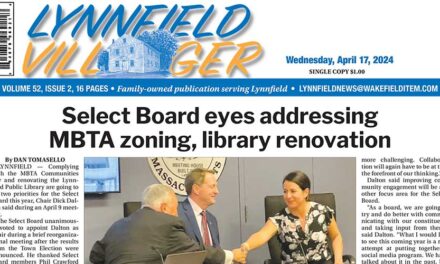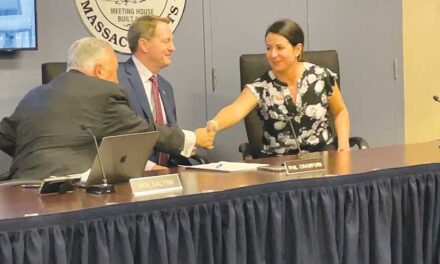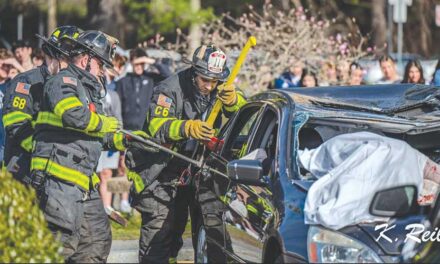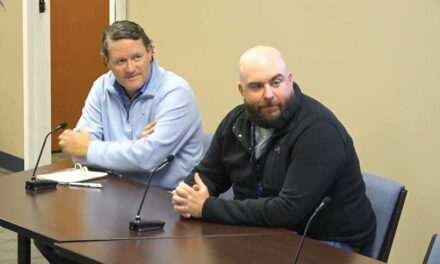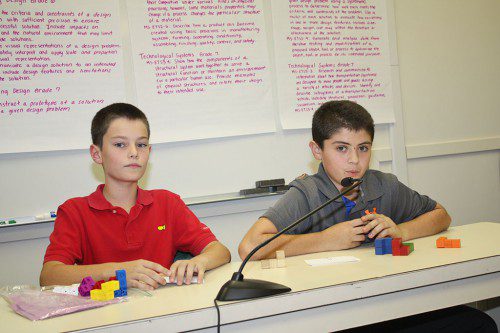
SIXTH GRADERS Domenico Simonetti (left) and Thomas Pascuccio discussed the puzzle cubes STEM project at the School Committee’s Nov. 4 meeting. (Dan Tomasello Photo)
By DAN TOMASELLO
LYNNFIELD — Middle school students are undertaking a variety of different STEM (science, technology, engineering and math) projects that are not only educational but also fun.
A group of middle school students discussed three different STEM projects during a recent School Committee meeting. Superintendent of Schools Jane Tremblay has introduced a new agenda item called “A Glimpse into the Classroom” for School Committee meetings. The program is designed to give the School Committee a better understanding of what is happening in the classroom each day.
Lynnfield Middle School STEM teacher Courtney Spencer said a STEM course was previously offered to only eighth grade students. She said the middle school now offers fifth, sixth, seventh and eighth grade STEM classes since LMS overhauled its schedule this year.
Spencer said the objective of the projects is to reinforce the STEM topics students are learning in class.
Sixth graders Thomas Pascuccio and Domenico Simonetti discussed the puzzle cubes project. Simonetti said they created a 3-D drawing before beginning the project to make sure the different blocks fit together. The two boys glued two-centimeter cubes into the particular shapes they wanted for their own individual puzzle.
The two students also gave the School Committee their own personal puzzle cubes and committee members attempted solving the puzzles.
“It’s pretty tricky,” said Spencer.
Seventh graders Grace MacDonald, Shannon Pierce, Abigail Lucich, Clayton Marengi and Daniel Mack discussed the bridge project. The project entails building a model bridge.
The students said the project has taught them about different manufacturing techniques. Students had to evaluate different materials to use before building the project. The seventh graders also created orthographic drawings before undertaking the bridge project.
After the drawings were completed, students determined what materials they were going to use to construct the bridge. Students also had to ensure all of the project’s parts fit together correctly to make sure the bridge was assembled correctly. Additionally, the project taught seventh graders about quality control and safety.
Eighth graders Abigail Murphy, Jenna Robbins and Emily Dickey discussed the solar car project.
Before building a model solar car, Robbins said eighth graders had to evaluate speed, torque and gear ratio. Afterward, students answered analysis questions after they finished conducting research. The students also watched a video to learn more about how to build a solar powered car.
Similar to the puzzle cube and bridge project, eighth graders had to create orthographic drawings before beginning the project. The students had a $60 budget to purchase materials for the project. Murphy said different group members were assigned different tasks as part of the project.
“Everyone got to do something,” said Murphy.
While undertaking the project, Dickey said the group’s car broke but the issue was quickly resolved.
“That didn’t stop us,” said Dickey. “We had time to fix the car.”
Robbins said they had to use battery packs during the eighth grade solar car race because there was fog outside. She said their car was the fastest car built and it traveled in a straight line, which impressed the school board.
SC reaction
School Committee Chairman Chris Barrett commended all of the students for the work they accomplished with the three projects.
“Outstanding job,” said Barrett. “You guys should all be proud.”
School Committee member Salvatore Cammarata said the Bureau of Labor Statistics compiled a “rather chilling report” in 2013 about the job market. According to Cammarata, the report revealed 70 percent of jobs unfilled in Massachusetts were in the STEM field. He noted there were thousands of people out of work but said they didn’t have the necessary skills to fill those jobs.
“This STEM work is absolutely critical to the future of our country,” said Cammarata. “Great work.”

